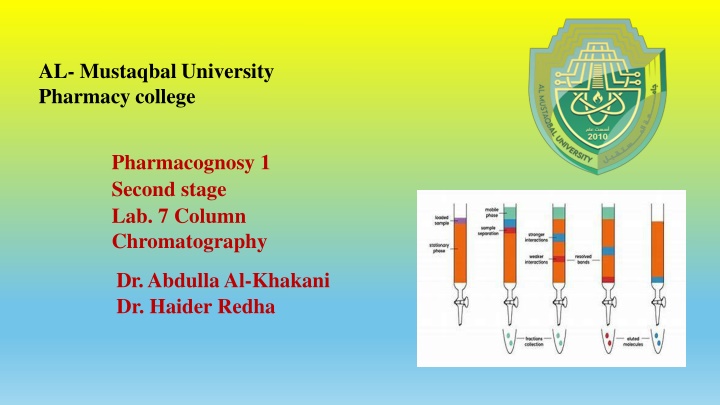
Column Chromatography: Techniques and Applications
Explore the world of column chromatography, a method used in pharmaceutical sciences for separating compounds based on their interactions with a solid or liquid stationary phase and a mobile phase. Learn about the different types of column chromatography, such as adsorption, partition, ion exchange, molecular exclusion, and affinity chromatography. Discover the packing and operating procedures of columns and various elution techniques like isocratic elution. Enhance your understanding of this essential laboratory technique through detailed explanations and visual aids.
Download Presentation

Please find below an Image/Link to download the presentation.
The content on the website is provided AS IS for your information and personal use only. It may not be sold, licensed, or shared on other websites without obtaining consent from the author. If you encounter any issues during the download, it is possible that the publisher has removed the file from their server.
You are allowed to download the files provided on this website for personal or commercial use, subject to the condition that they are used lawfully. All files are the property of their respective owners.
The content on the website is provided AS IS for your information and personal use only. It may not be sold, licensed, or shared on other websites without obtaining consent from the author.
E N D
Presentation Transcript
AL- Mustaqbal University Pharmacy college Pharmacognosy 1 Second stage Lab. 7 Column Chromatography Dr.Abdulla Al-Khakani Dr. Haider Redha
Column Chromatography This includes chromatographic methods in which: The stationary phase is either solid or liquid packed into a column. The mobile phase is a moving liquid or gas. According to the mechanism of separation of solutes, five major types of CC are distinguished. Usually, one mechanism predominates but does not exclude the others.
Mode or type Adsorption Stationary phase Solid that attracts the Mobile phase Liquid or gas Mechanism Solutes move at different Chromatography solutes rates according to the forces of attraction to the stationary phase. Partition Thin film of liquid Liquid or gas Solutes equilibrate Chromatography formed on the surface of a between the 2 phases solid inert support according to their partition coefficients Ion Exchange Solid resin that carries Liquid containing Solute ions of charge Chromatography fixed ions & mobile electrolytes opposite to the fixed ions counterions of opposite are attracted to the resin by charge attached by electrostatic forces & covalent bonds replace the mobile counterions.
Mode or type Stationary phase Mobile phase Mechanism Molecular Exclusion Porous gel with no Liquid Molecules separate Chromatography attractive action on solute according to their size: molecules Smaller molecules enter the pores of the gel, And need a larger volume of eluent. Larger molecules pass through the column at a faster rate. Affinity Chromatography Solid on which specific Liquid or gas Special kind of solute molecules are immobilized molecules interact with those immobilized on the stationary phase
Column chromatography Stationary phase is held in a narrow tube through which the mobile phase is forced under pressure or under the effect of gravity.
Packing & operating the column: 1- Packing The selection of the method of packing depends mainly on the density of the solid. Techniques used are the wet, dry & slurry methods. In all cases avoid inclusion of air bubbles. 2- Sample Application Apply evenly & in a concentrated solution to the top of the column which is protected from disturbance (e.g. add glass wool or filter paper).
3-Elution techniques: Technique Isocratic elution Procedure Addition of solvent mixture of fixed composition during the whole process. Continuous or linear elution: in which there is continuous change in the composition of the mobile phase over a period (e.g. polarity, pH or ionic strength). Gradient elution Step wise or fractional elution: in which the change is not continuous i.e. a sudden change in the composition of the mobile phase is followed by a period where the mobile phase is held constant
4- Detection: On column detection for colored or fluorescent compounds directly after developing the chromatogram. 1. Monitoring of eluted fractions (PC or TLC). 2. Using special detectors connected to the column such as refractive index, UV detector.















